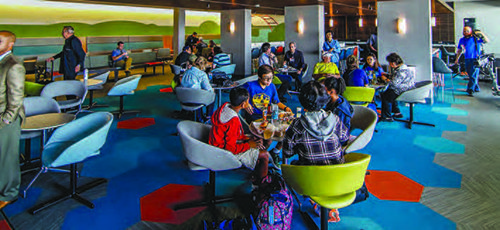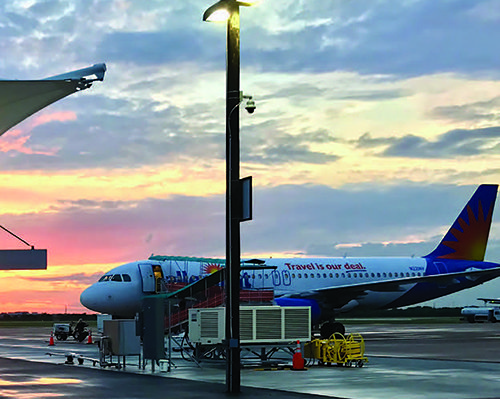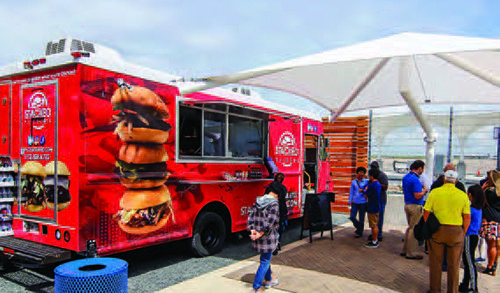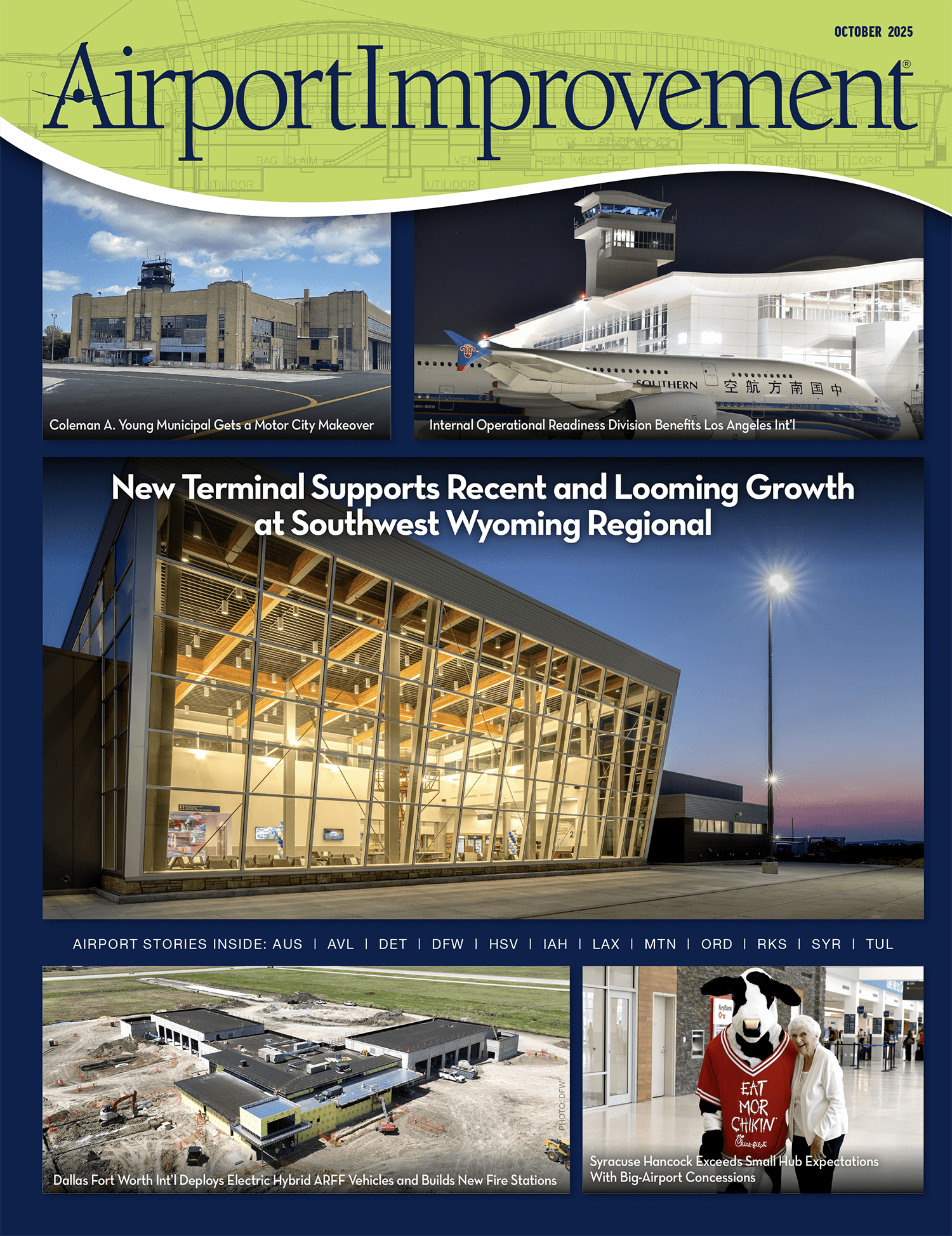The city of Austin, TX, has been expanding rapidly for the past several years, with no discernable end in sight. Last year, its population grew by 2.9% (nearly 60,000 people) and forecasters predict that the city will reach the 3 million mark before 2030. As of this March, Austin was home to more than 2 million residents.
Locals attribute growth to ample job creation, pleasant weather, great live music and an overall high quality of life. While the population boom has been wonderful for business expansion and real estate values, it was straining the seams of the Barbara Jordan Terminal at Austin-Bergstrom International Airport (AUS).
“When the airport was built in 1999, it was designed for a capacity of 11 million passengers,” says Airport Director Jim Smith. “We blew through that a few years ago. We’re probably going to go over 13 million this year.”
| P3s Defined A public-private partnership (P3) is a contractual arrangement between a public agency (federal, state or local) and a private sector entity. Through this agreement, the skills and assets of each sector (public and private) are shared in delivering a service or facility for the use of the general public. In addition to the sharing of resources, each party shares in the risks and rewards potential in the delivery of the service and/or facility. – The National Council for Public-Private Partnerships |
So AUS is maximizing its current facilities and adding new infrastructure to alleviate that stress. In mid-April, the city-owned airport officially opened the doors to its new South Terminal, facilities created specifically for low-cost carriers in a building that had previously stood vacant for years. In 2019, AUS is scheduled to unveil a nine-gate expansion to its main terminal that will increase its capacity to 15 million annual passengers.
 “That should set us up for a period of time,” reflects Smith. “But if this growth stays constant, which is twice the rate going at a national basis, we’ll have to initiate another expansion.”
“That should set us up for a period of time,” reflects Smith. “But if this growth stays constant, which is twice the rate going at a national basis, we’ll have to initiate another expansion.”
Accommodating Growth
To provide more flights for its rapidly growing city, AUS turned to the fastest-growing airlines in the area: low-cost carriers. Specifically, Smith approached incumbents Frontier Airlines and Allegiant Air, and both expressed interest in expanding their service at AUS.
With more than 57 consecutive quarters of profitability and new aircraft on order, Allegiant is particularly in synch with Austin’s growth curve.
“We had our first brand new Airbus shipped, and nine more will come online this year,” reports Daniel Meier, Allegiant Manager of Airports. “All of our MD-80s will be gone by the end of 2019, and our last 757 retires in November of this year. The new Airbus aircraft are more fuel efficient and more reliable, which results in fewer delays and mechanical disruptions.”
Knowing that the airport’s low-cost carriers were interested in expanding service at AUS, Smith reached out to Oaktree Capital Management in 2015 to discuss public-private partnership (P3) options for renovating an existing building located about 8.5 miles (by public roadway) and 20 minutes from the main terminal. Given the pressing need, Smith reasoned that a P3 would be able to move ahead with the project more quickly than the city could. (See sidebar for more info about the alternative project delivery method.)
After receiving approval from the city council to move forward with a P3 plan, the city negotiated and executed a lease. By summer 2016, crews were renovating a vacant building that was originally built as a motor pool maintenance facility by the Air Force in the 1960s. Viva Aerobus, a low-cost Mexican carrier, had taken over the building in 2007 and commissioned it as an international arrivals terminal. Hampered by the recession, the budget carrier only operated there until 2008, and the facility was mothballed until AUS recently repurposed it once again.
Now, LoneStar Airport Holdings, a portfolio company of Oaktree, holds the 30-year lease and concession agreement with Austin Aviation Department for the building, renamed the South Terminal. Under the agreement, LoneStar will manage and operate the passenger building and also plan, direct and finance the future development of the South Terminal.
“Oaktree, like so many other private investment firms, has been interested in P3 arrangements across numerous sectors,” says LoneStar Chief Executive Officer Jeff Pearse. “In North American markets, there aren’t many examples of
 facts&figures facts&figuresProject: New Terminal for Non-Legacy Carriers Location: Austin-Bergstrom (TX) Int’l Airport Strategy: Rehab vacant airport building via a public-private partnership Est. Cost: $12 million Timeframe: 8 months Gates: 3 Current Carriers: Allegiant Air; ViaAir Coming Soon: Sun Country Project Manager/Owner: Oaktree Capital Management Interior Design: Fentress Architects Construction: AECOM Hunt Electrical/Mechanical Design & installation: Bay Engineering Canvas Canopies: FabriTec Primary Benefits: Decrease strain on main terminal; encourage non-legacy carriers to expand Boarding Ramps: KCI Additional Benefit: City ensured that new terminal met industry & local guidelines but didn’t have to plan & design it. |
private management existing currently; our goal was to try to really leverage the FAA’s privatization pilot project to show that it’s a viable concept in terms of funding capital development at airports.”
Smith notes that P3 projects are not new for AUS. “We have a cargo facility, hotel, gas station, consolidated rental car facility and cellphone lot with restaurant, all set up under this model,” he relates. “It’s an alternative way to deliver on an airport, and our experience has been very positive. We think it’s going to be a demonstration of how successful P3 can be.”
New Life for Old Terminal
Fentress Architects worked closely with LoneStar and under the supervision of AECOM Hunt to transform the mothballed terminal into a facility that would help relieve congestion in the airport’s main terminal. (AECOM Hunt formed in 2014, when engineering design giant AECOM acquired Hunt Construction Group to significantly increase its construction service capabilities.)
Pearse describes the project as a total gut job. “We poured $12 million into this project, and the result is a radical transformation from what it was before,” he explains. Previously, most of the terminal had been dedicated to Customs and Border Protection operations for international flights, and all of that infrastructure was pulled. Designers also flipped the locations of the ticketing and baggage claim areas and streamlined the security checkpoint.
Eric Howe, project director at AECOM Hunt, notes that his firm worked closely with the architects to ensure that the project stayed within budget yet still delivered the high-end look LoneStar wanted. One strategy was re-using existing light fixtures in back-of-house spaces to free up funds for new, decorative light fixtures in public spaces.

“We added new walls, new finishes, new paint, and painted the outside of the building to freshen up the building, which had been sitting vacant for a few years,” says Howe. New canopies accented with variable lighting helped add a desired “wow factor.”
Currently, the South Terminal is home to two carriers: Allegiant, which flies to 10 nonstop destinations from AUS; and ViaAir, with weekly departures to Branson, MO. The 30,000-square-foot facility includes its own TSA checkpoint, baggage claim belt and ticket counters. Giant windows behind the ticket counters showcase aircraft on the tarmac, and murals of Austin adorn the walls.
Baggage Claim is located close to the aircraft parking area, which means luggage begins to roll around the collection belt quickly.
“South Terminal was designed to fit the low-cost business model,” explains Smith. “We eliminated boarding bridges and fancy baggage systems to save money. Passengers walk up ramps, not an air-conditioned contact bridge. The design harkens back to mid-century air travel, when everything was simpler.”
Meier notes that outdoor ground boarding makes sense in Austin, because its weather is favorable all year long. The arrangement also allows Allegiant to board from the front and back of the aircraft simultaneously, which saves time and money.
Terminal amenities include a convenience shop with pre-made sandwiches and snacks, vending machines and an outdoor patio with tables, couches, a pet relief station and food trucks. Designers specified soft lighting in the middle of the hold area to create a lounge feel, and provided several counters with outlets for charging mobile devices.
Lower Rent
Strategic renovations of the abandoned facility allowed AUS to hold down rent for the new terminal to approximately 50% of what carriers pay in the main terminal.
“When Allegiant was in the main terminal, the cost per enplaned passenger was $8.30,” shares Pearse. “In the new terminal, it’s going to be around $2 per enplaned passenger.”

Such substantial cost savings will attract more carriers to the South Terminal, he predicts. This summer, ViaAir and Sun Country will run seasonal flights from the newly renovated facility, enjoying the same financial benefits as Allegiant.
“Our most important advantage is that we offer access to this robust market at less cost than the main terminal,” says Pearse.
New Terminal, New Arrival Process
One of the biggest challenges for LoneStar and the city’s aviation department has been educating passengers about the new South Terminal-specifically how to find it and to use its associated parking structure.
“We’re getting a larger number of people than we anticipated showing up at the main terminal for their flight instead of going straight to the South Terminal,” says Smith. “Over time, it will get easier.”
A free shuttle bus consequently makes frequent trips between the main Barbara Jordan Terminal and the new South Terminal, as the two buildings are serviced by different entrance roads and are not physically connected with one another. Ideally, LoneStar and Allegiant would prefer to have more signage on and off the airport grounds.
Ideally, LoneStar and Allegiant would prefer to have more signage on and off the airport grounds.
In the meantime, Allegiant emails all customers booking online, emphasizing that they will depart out of the South Terminal. Passengers also receive reminder emails with a map and the terminal address one week before their flights. In addition, Allegiant drives the point home on social media and its blog, and is working on a text system to communicate with passengers departing from AUS.
If passengers miss their flights after going to the wrong terminal, Allegiant maintains a “generous re-accommodation policy,” says Meier, noting that the terminal is still very new. Even customers who are initially frustrated about the difficulties they encounter finding the South Terminal are delighted once they walk in the front door, says Courtney Goff, a public relations specialist for Allegiant.
“We’re striving to create a stress-free customer experience,” she says. “The South Terminal offers an easy way to drop people off, find their gate, check their bags, and get through Security. Many of our customers travel once a year or so, and they might get flustered by large terminals. It’s great for the infrequent traveler; the ease and convenience is great for elderly travelers and families traveling with children, as well.”
and they might get flustered by large terminals. It’s great for the infrequent traveler; the ease and convenience is great for elderly travelers and families traveling with children, as well.”
Even with initial confusion about its location, the new terminal itself is very convenient, says Pearse. Discounted parking ($8 to $16 daily vs. $18 to $27 per day at the main terminal) should help entice passengers to head directly to the South Terminal, he adds.

Smith, who has spent the last 33 years with the city of Austin, is convinced that the new terminal would not have been ready as quickly as it was without using a P3 model. “This is a gamble on all of our parts-passengers have to go to a separate location to get to this terminal,” he notes. “It’s an experiment to see if the value to the LCCs [low-cost carriers] is enough to see if they will grow vs. the connectivity for the main terminal. Time will tell, ultimately, whether the fundamental premise behind this model will work.”
That said, he’s placing his bets on success-even as he acknowledges some of the early challenges.



